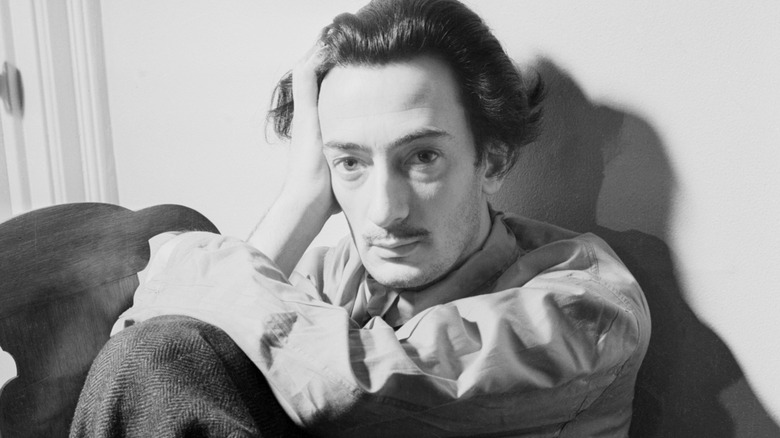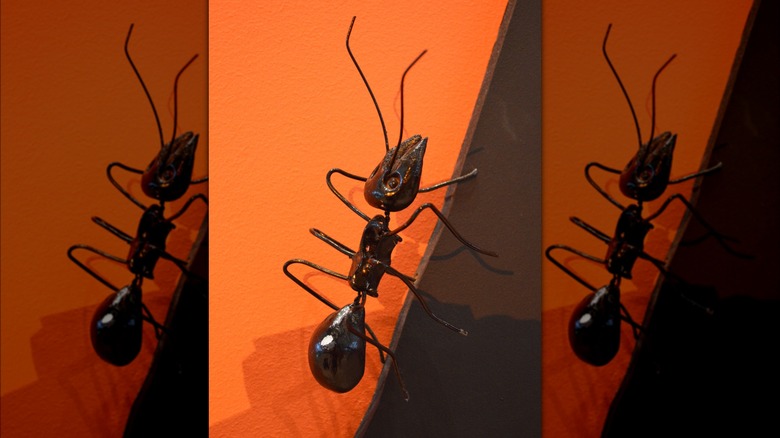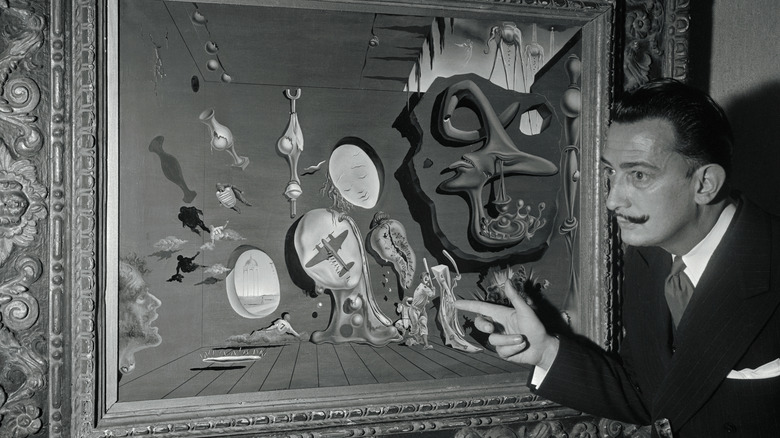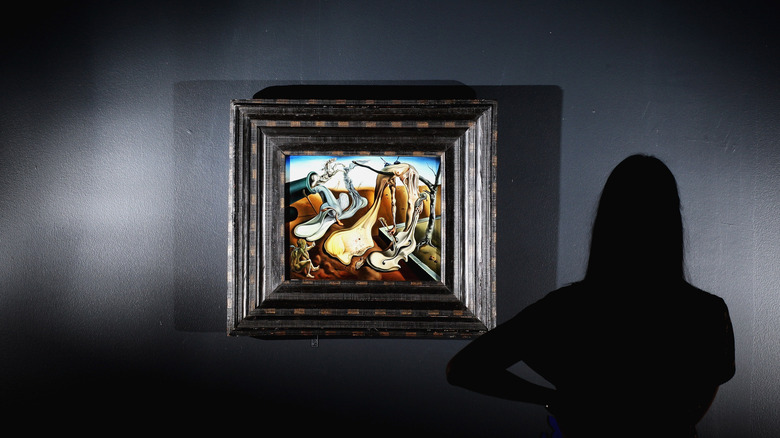The Thing That Salvador Dali Feared Most In Life
Heroic eccentric Salvador Dali used his bizarre imagination to conjure incredible surreal images: melting clocks, elephants with stilt-like legs, and eerie desert landscapes. But Dali's imaginative offerings were not random, they were attempts to explore the human mind at a time when Sigmund Freud had just introduced the world to the concept of the human unconscious.
As in a dream, our hopes and fears are relayed back to us in Dali's paintings through his confusing and sometimes frightening imagery. They also give us a chance to psychoanalyze the man himself, who boldly splashed some of his own fears across the canvas.
Ants and grasshoppers are particularly common motifs in Dali's work and they feature time and again, hidden in his many paintings as dark symbols. For example, you may or may not have noticed that amid the oozing clockfaces in Dali's best-loved painting, "The Persistence of Memory," a pocket watch in the corner is covered in a swarm of tiny ants. This is no accident — Dali was petrified of insects to a degree that went way beyond ordinary squeamishness.
Dali's insect-related trauma
Like many of us, Salvador Dali was horribly traumatized by creepy crawlies as a child, and it saddled him with a lifelong fear and odd fascination. Dali wrote about several unsettling incidents involving bugs in his autobiography, "The Secret Life of Salvador Dali," a book that serves as a useful compendium for decoding his paintings.
For example, as a young boy, Dali took in an injured bat, which he and his cousin put in a tin pail. One day, Dali, who loved the furry-winged biped, was horrified to discover that the unfortunate creature had been attacked by some unwanted visitors. He recalled: " ... the bat, though still half-alive, [was] bristling with frenzied ants, its tortured little face exposing tiny teeth like an old woman's."
The ant incident upset Dali, but far worse than ants were grasshoppers — a bug Dali described in the most dramatic language imaginable. After noticing that the tiny faces of grasshoppers resembled those of a scary-looking fish he had once caught, Dali was permanently disturbed by them. "I saw them everywhere, even where there were none: a grayish paper, suddenly seen, and looking to me like a grasshopper, would make me utter a shrill cry which delighted everyone ..." Dali's fear was made that much worse by other children, who had their fun by scaring him with the insects at every opportunity.
Crawling skin and creepy canvases
As an adult, Salvador Dali never did get over his fear of bugs. According to the Smithsonian, he may even have suffered from Ekbom's Syndrome, a rare psychological condition in which patients feel as if invisible bugs are crawling all over their skin.
Dali received this posthumous diagnosis due to his recollection of a particularly gruesome incident that occurred after spotting some bugs in a Paris hotel room. Upset by the creatures, Dali became convinced a spot on his back was a tick and resorted to violently scrapping it off with a razor. By the time a doctor arrived, Dali realized "It was neither a bedbug nor a tick nor a cockroach nor a siamese-twin that had been stuck to my skin — all this had existed only my imagination. It was simply a small birthmark that I had seen a hundred times before" (via "The Secret Life of Salvador Dali").
Grasshoppers in particular would continue to haunt Dali throughout his life, although they also continued to give him spooky inspiration. He wrote, "I am thirty-seven years old, and the fright which grasshoppers cause me has not diminished since my adolescence. On the contrary. If possible. I should say it has perhaps become still greater. Even today, if I were on the edge of a precipice and a large grasshopper sprang upon me and fastened itself to my face, I should prefer to fling myself over the edge rather than endure this frightful 'thing.'" Grasshoppers appear in many of Dali's works, as a symbol of fear itself.
Insect anxieties
Understanding Salvador Dali's lifelong terror of bugs serves as a useful key to unlocking the meanings behind many of his works. According to an article Published in Surreal Entomology, roughly 10% of Dali's 1,176 paintings feature insects, including 10 terrifying grasshoppers, 50 paintings filled with ants, and a host of others containing butterflies and flies.
Often, the canvases that feature insects have disturbing or upsetting themes, such as death and decay. Dali's "Daddy Longlegs of the Evening— Hope!" for example, features a melting human body crawling with ants and a hideously distorted crane fly. This painting was created at the beginning of the Second World War and is believed to be a commentary on the war itself.
On the other hand, ants and grasshoppers also regularly feature in paintings related to Dali's sexual anxieties, including his famous "The Great Masturbator," in which a giant distended face is embraced by a giant ant-covered grasshopper. Similarly in his painting "The Font," another painting which features Freudian sexual allusions, a woman's sealed mouth is depicted covered with ants.



